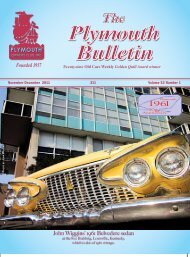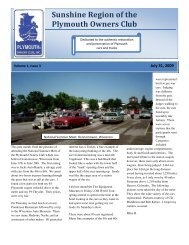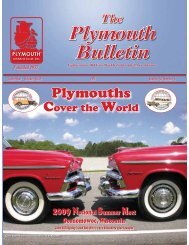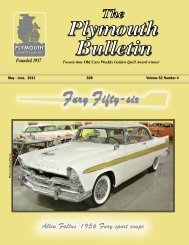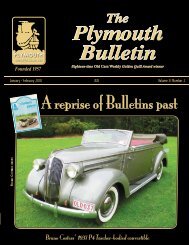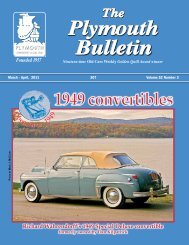296 - FULL ISSUE - Plymouth Club
296 - FULL ISSUE - Plymouth Club
296 - FULL ISSUE - Plymouth Club
- No tags were found...
Create successful ePaper yourself
Turn your PDF publications into a flip-book with our unique Google optimized e-Paper software.
<strong>Plymouth</strong> and LincolnZephyr to Tucson,Arizona, where we hadretired. When he wentto pick up the car fromthe storage location, hefound the moths hadeaten the fabric, and thebrakes were frozen.That made for a delicatesituation as heloaded the car on thetrailer for the four-daytrip from Pennsylvaniato Arizona.It soon becameobvious that the<strong>Plymouth</strong> would needsome work to restore it to pristine condition. Being new toArizona, we began the restoration by asking club memberswhere we could get this and that work done. We found thatthe engine, which has 105,000 miles, and other critical partsof the <strong>Plymouth</strong>, did not need major work. Although we werein the early stages of the restoration, we decided to participatein the National AACA Founders Tour of Arizona, which covereda large part of the state. On the first day out, while wewere traveling through the White Apache Indian Reservationin northern Arizona, we were hit not once, but twice, byanother vehicle, which extensively damaged the driver’s sideof the car and shook both of us quite a bit. After all the policework was done, my husband looked over the car and foundthat it was driveable, so we proceeded down the road andcompleted the tour.We realized the damage provided us with an opportunityto have the repair work done to bring the car up to nationaljudging standards. While taking damaged parts off the car, wefound several large holes underneath the front and back seats,the wiring for the whole car badly worn, that lots of thechrome was pitted, that new upholstery and head liner wererequired and new tires were needed to replace the older tiresthat were barely used since they were bought in the 1970s.Then, there were a number of small jobs to be done on variouslocations around the car.Well, the hard work paid off, as we were awarded the firstnational junior trophy in 2007 followed by a national senioraward in 2008 at AACAnational meets. Thesewere our first nationaltrophies since we wereawarded first prizes bythe <strong>Plymouth</strong> 4 and 6Cylinder <strong>Club</strong> (forerunnerto the <strong>Plymouth</strong>Owners <strong>Club</strong>) at theNew Hope,Pennsylvania, andOwensboro, Kentucky,shows in the mid 1970s.In September this year,we plan to present ourcar for the NationalAACA Preservationaward. Also, we haveearned a number of trophies from local, regional and Arizonacar shows and meets. When the next national <strong>Plymouth</strong>Owners <strong>Club</strong> meet comes to the western states, we hope toshow the car.The other day, I was saying to myself that Granddadwould be pleased to see his car restored to its original condition.It continues to receive praises from and revive nostalgicmemories for meet attendees and honks on the road, whichremind me of the day he drove this car to my parent’s houseso long ago. My Granddad was proud of the fact that manyNASCAR racers used this type of <strong>Plymouth</strong> to win races untilthe high compression engines emerged on the scene. I thinkhe is smiling now.Background:The car was assembled in Detroit, Michigan,in late November, 1950, and purchased in early December,1950. It is a 1950 <strong>Plymouth</strong> P19 two-door Deluxe fastback.The total 1950 car production of this body style was 67,584.Less than 5,000 were produced after my granddad’s car. Total<strong>Plymouth</strong> production of all body styles in l950 was 610,936cars.Options purchased for the car include a heater, a radio, aFram oil filter, a cigarette lighter and turn signals; color:Channel Green.PHOTOGRAPHS TAKEN BY DON SPIRO OF TUCSON, ARIZONA-35-



